The Indian Premier League is certainly an event of global grandeur in the cricketing world. After a delayed start due to logistical challenges within a COVID-ridden India, the BCCI had to shift the cash-rich tournament to the Arab Emirates for safe and smooth conduct of play. After fifty-plus season matches so far, we have finally landed in the fag end of the tournament. There can be no doubt that this season of the IPL has been one of the most interesting in terms of play-off qualification math that went behind the games.
Traditional performers as the Chennai Super Kings and the Kolkata Knight Riders were a major disappointment this year, while relative underdogs as the Royal Challengers Bangalore, Sunrisers Hyderabad and Kings XI Punjab displayed remarkable grit in their quest for the trophy. As such, several statistics have come out and many records have been broken as well. Questions as who scored the most number of runs, or claimed the most number of wickets, are easily obtainable. What is obscured behind the mammoth data are the finer details that have a significant impact on the results. From over thirteen thousand ball-by-ball records of this year’s edition of the IPL, and with the help of computational software, I have broken the data into several angles that provide a better perspective on the game. The data displayed is representative of matches that were conducted before the qualifiers began, that is till the group stage. If you wish to obtain the dataset, you’re most welcome to contact me.
Batting Statistics
1. Runs Scored Overall
The batting credibility of a team is an essential constituent of T20 success. The fact is reaffirmed by the observation which includes MI, SRH and DC- teams that have gone on to play the qualifiers- as the top-4 amongst the highest run scorers throughout the length of the season. KXIP’s consistently performing KL Rahul and Mayank Agarwal are the reasons behind its inclusion onto the second spot. Mumbai’s power hitters, namely Ishan Kishan, de Kock, Pollard and Pandya have ensured a smooth sail for Mumbai so far.
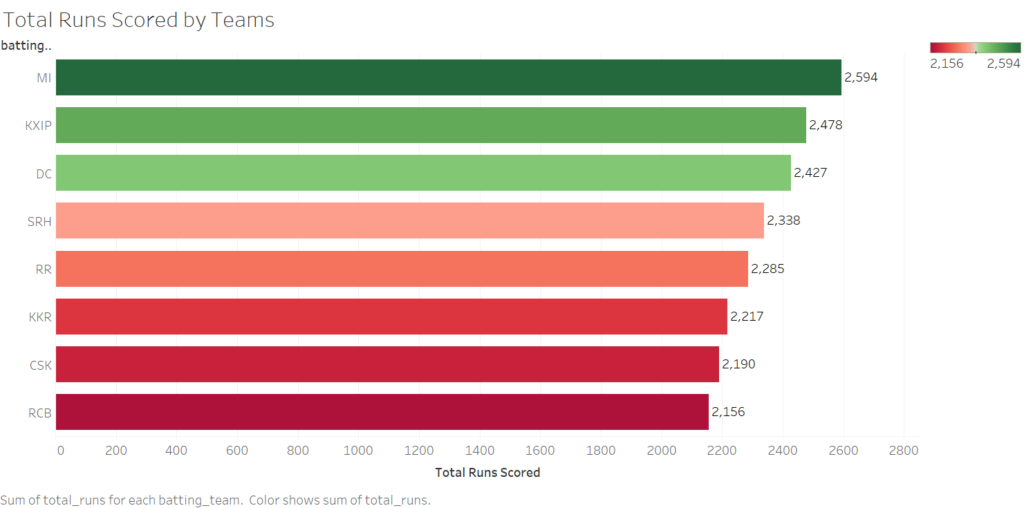
2. Runs Scored in Death Overs (15-20)
Let us now evaluate this metric under the scanner. In T20 format, while a quick start is crucial to a team getting a decent cushion to defend, it is also essential to fire during the death overs. Mumbai’s consistency and big-hitting towards the rear end of the match has placed them in a commanding position yet again. Same has been the story for Delhi, while Kolkata’s Morgan has mostly been responsible for the inclusion at the third place. Chennai has made a surprise entry due to the likes of Jadeja and Sam Curran’s boundary-clearing abilities. Sunriser’s over-reliance on Warner and Saha is clearly evident as by the time it reaches the death, the team fizzles out on its batting ability.
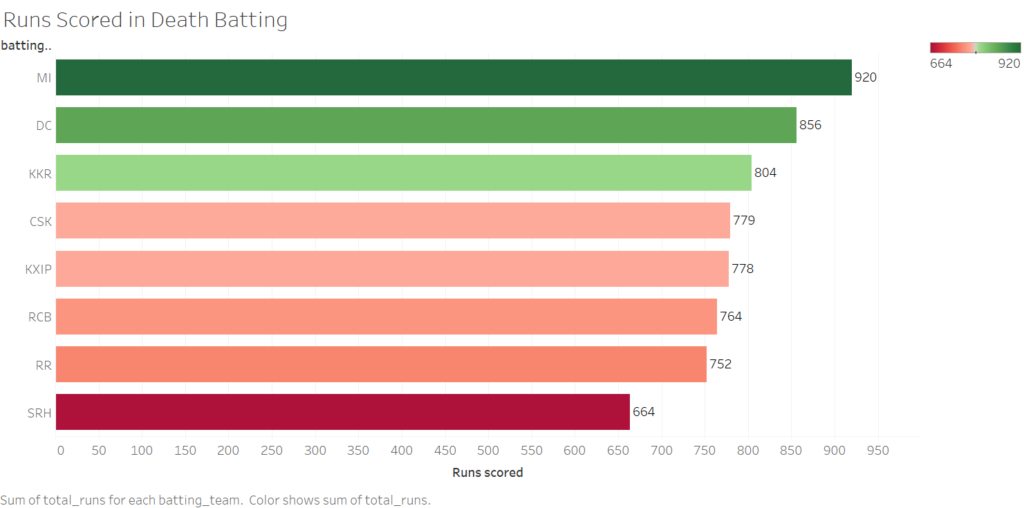
3. Most Boundary Runs within PowerPlay (Overs 1-6)
The adage get off to a flyer holds true, more often than not, in Cricket’s shortest format. In terms of player ranks, I have ordered top scorers who charge after the ball within the first six overs. The first six overs have a field restriction on, which aids better scoring. de Kock, who has shown remarkable prowess with the willow this season and opens for the formidable Mumbai Indians, shares the top spot with KXIP’s only redeeming grace this year- KL.
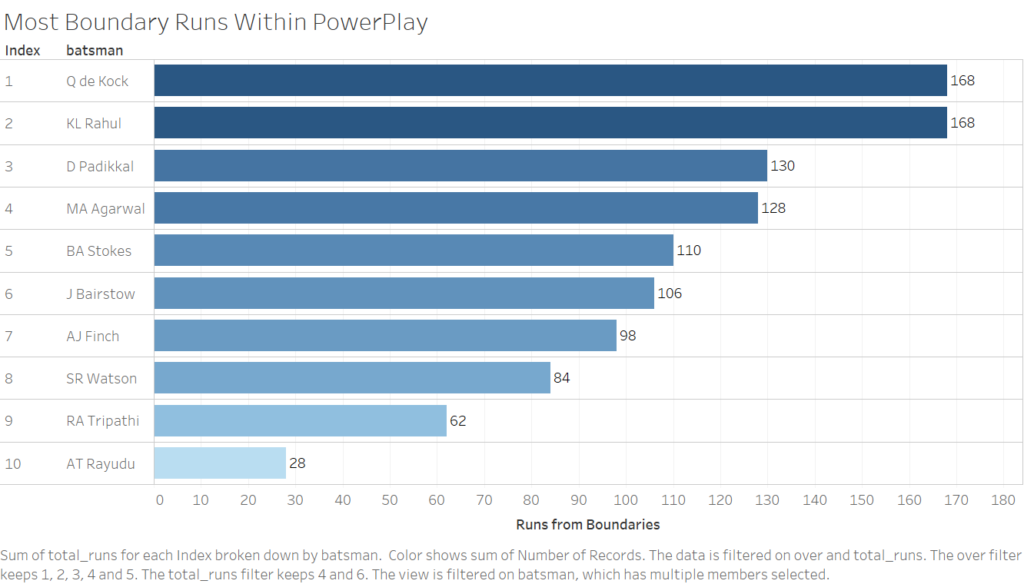
4. Boundary Runs Scored by Team
Boundaries help in quickfire run-scoring and shifts the pressure from the batting side to the bowling team. The aggregate runs scored in form of boundaries, which includes fours and sixes, again sees Mumbai securing the top place. Punjab’s striking ability makes it the second on this list. Despite big names on the roster, RCB’s boundary-hitting is seriously deplorable. No wonder why they failed in crucial matches. Even Chennai, whose batting has been pathetic for a greater stretch of the season, fares better than RCB.

5. Dot Balls Played by Teams
A string of dot balls often puts the worry on the batting team to up the ante and put the foot on the gas. Furthermore, while dot balls are important in the initial stages to ascertain the pitch nature and swing if any, too much of dot balls also takes away run-scoring opportunities. The UAE’s slow pitches made it very hard for most teams to pick lengths appropriately and thereby, mis-time the ball or end up not making a connection at all. Here’s a relative analysis of the most dot balls played by team.
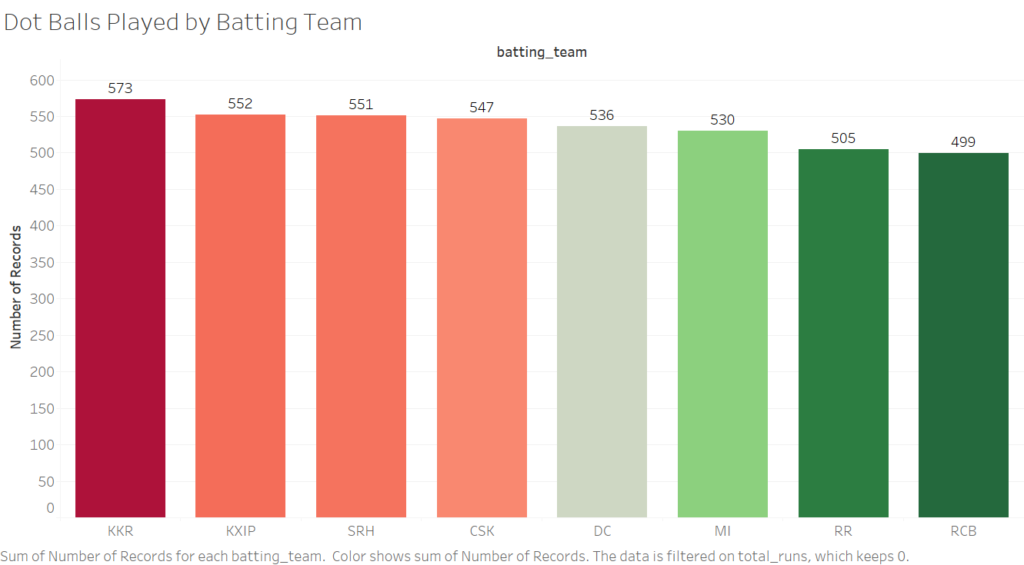
6. Dot Balls Played in Death Overs, by Team
T20 requires unconditional big-hitting in the death overs, to ensure a chance of having any real success of winning. Dot balls are a big dampener for the audience- who seek the thrill of experiencing a smorgasbord of boundaries in the end overs- as well as the batting team. Dot balls in the death are a serious concern and must be addressed. While Mumbai again fared very well on this front, Punjab, Kolkata, Hyderabad, and Delhi failed to capitalise on the death overs and instead, succumbed to pressure.

7. Most Batting Collapses due to LBWs, by Team
Leg-Before-Wickets have been one of the more interesting aspects of the game. Non-cricket enthusiasts find it hard to grasp what an LBW appeal really means, but for those who understand, LBWs are clearly a bone of contention. With DRS enabled, however, decision-making has become more transparent. Getting out by LBW often means a failure to judge the swing, or the spin direction of the ball. Delhi’s Shreyas, Shikhar and others have often been trapped in the legs a number of times. So is the case with Chennai’s Watson, Faf, Rayudu and even MS Dhoni. No wonder they figure second. Mumbai again, has the least LBW dismissals.
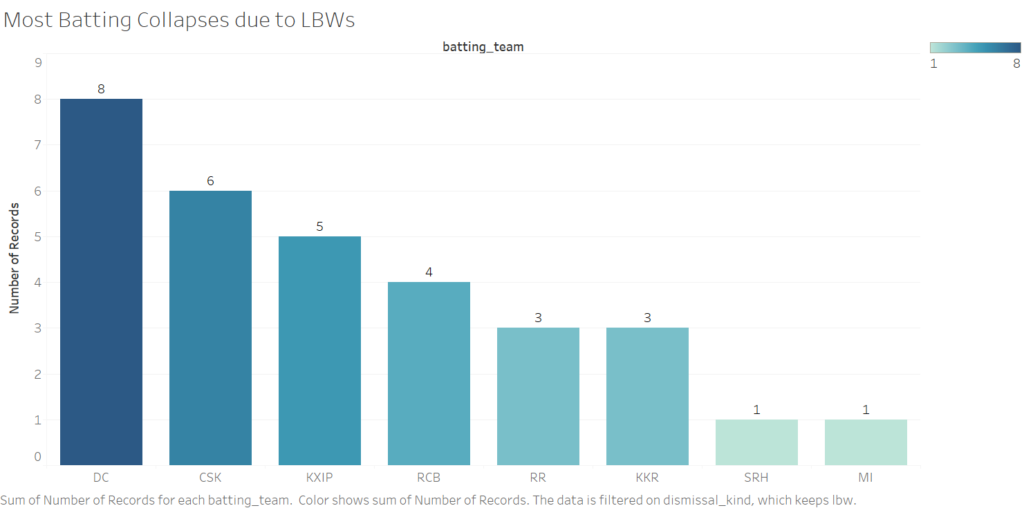
Bowling Statistics
1. Runs Given Away by Bowling Teams
Leaking runs has been a perennial worry for several teams throughout the season. Rajasthan’s poor bowling has been a consistent sore, with them leaking a cumulative 2,471 runs. Delhi, which had the impressive likes of Rabada and Nortje, were too expensive. Surprisingly, RCB had the most economical bowling, ranking first in terms of the least number of runs given away. Mumbai, which has been phenomenal in all other departments, fares average here.
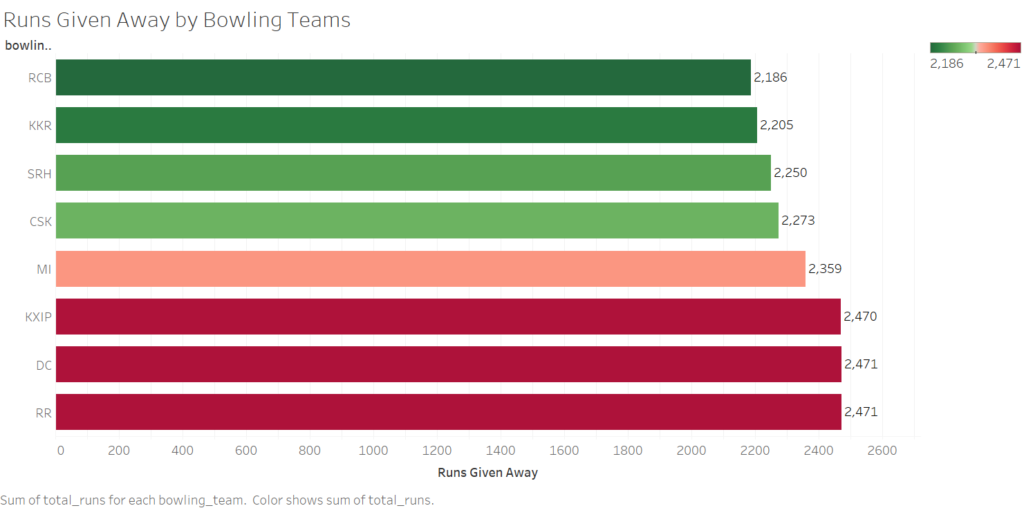
2. Runs Leaked in Death Overs, by Team
Good death bowling is the hallmark of a team that is destined to win. By constricting the opponent to bat for singles and twos at most, the bowling team can give themselves a good chance to win the game and make it hard for the batting side. Rajasthan’s poor bowling shines through again, a strong reason behind their dismal performance this season on all fronts. KKR’s Varun Chakravarthy, a surprise find, and younger talents like Nagarkoti, have sealed KKR as the most economical side during the death.
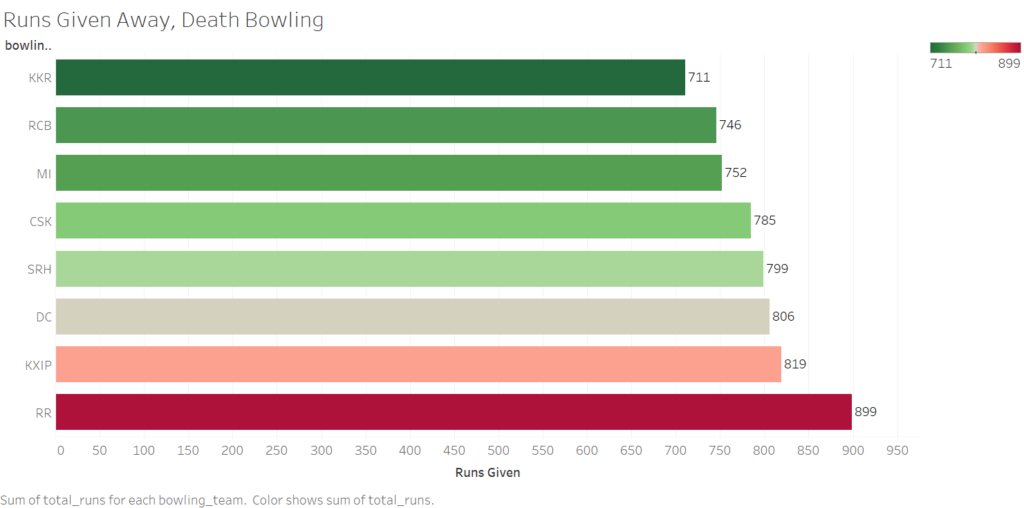
3. Wide Runs by Team
Wide runs are often a result of frustration and indiscipline on part of the bowler. Sometimes, bowlers try too hard to bang in the ball and surprise the batsmen after getting smacked that their focus entirely shifts from the line and length of the ball. If it goes past the keeper towards the boundary for a wide and four runs, it is even worse. Kings XI’ and Rajasthan’s bowling inconsistency can be established from the following graphic. Mumbai has also had a considerable share of wide balls being bowled.
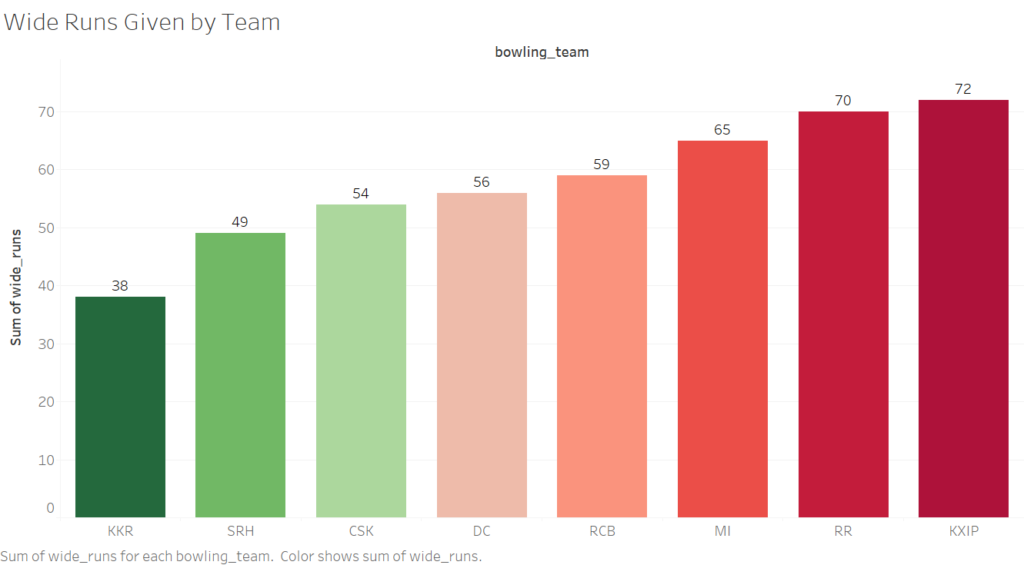
4. Most No-Balls bowled by Teams
No-balls are an absolute no-no in T20 format. No balls not only extend a free run to the batting team, but also gives the perilous Free-Hit to the on-strike batsman. While no-balls due to overstepping have been considerably low this season, beamers have been a worry. Lockie Ferguson’s no-ball in the death against CSK single-handedly turned tables in Chennai’s favour from a near-impossible situation, which Chennai went on to win. However, it is Chennai who has leaked the most number of no-ball runs, followed by Rajasthan and Bangalore.
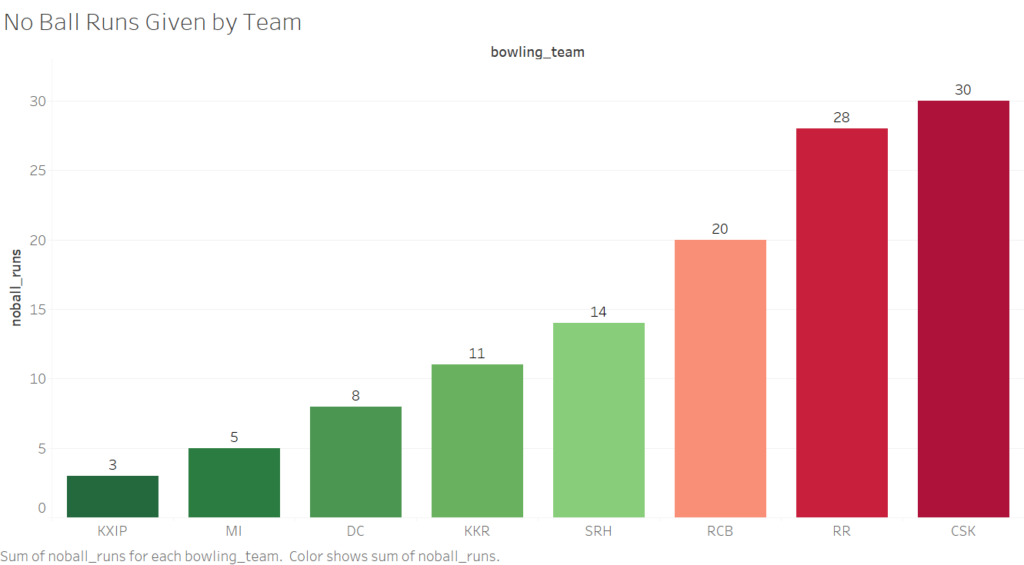
5. Most Clean-Bowled Dismissals by Team
The sound of the ball hitting the timber is certainly the sweetest sound for a bowler. And sure it is for the bowling team. Clean-bowled dismissals indicate disciplined bowling lines and wicket-to-wicket bowling, which makes it hard for the batsmen. Sunrisers have impressed the most in terms of hitting the wickets with the ball. So has RCB, which played an array of seamers. Chennai and Rajasthan have found the luck only occassionally.
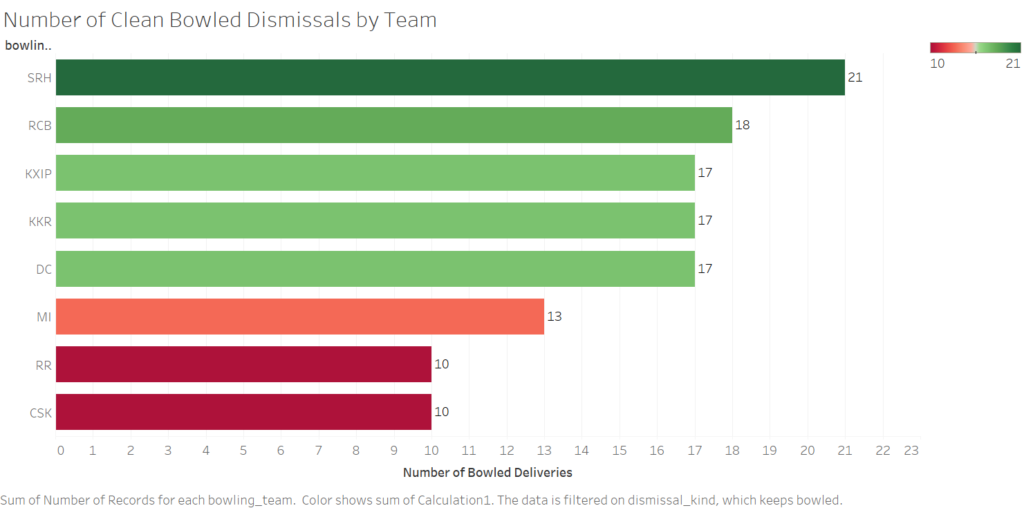
6. Most wickets in PowerPlay overs, by Team
Striking early often takes the steam out of the batting team and demoralises the incoming batsman, forcing them to take cautious steps. Mumbai’s Jasprit Bumrah has been exceptional on this front, as he scalped 5 wickets for Mumbai with the new ball.
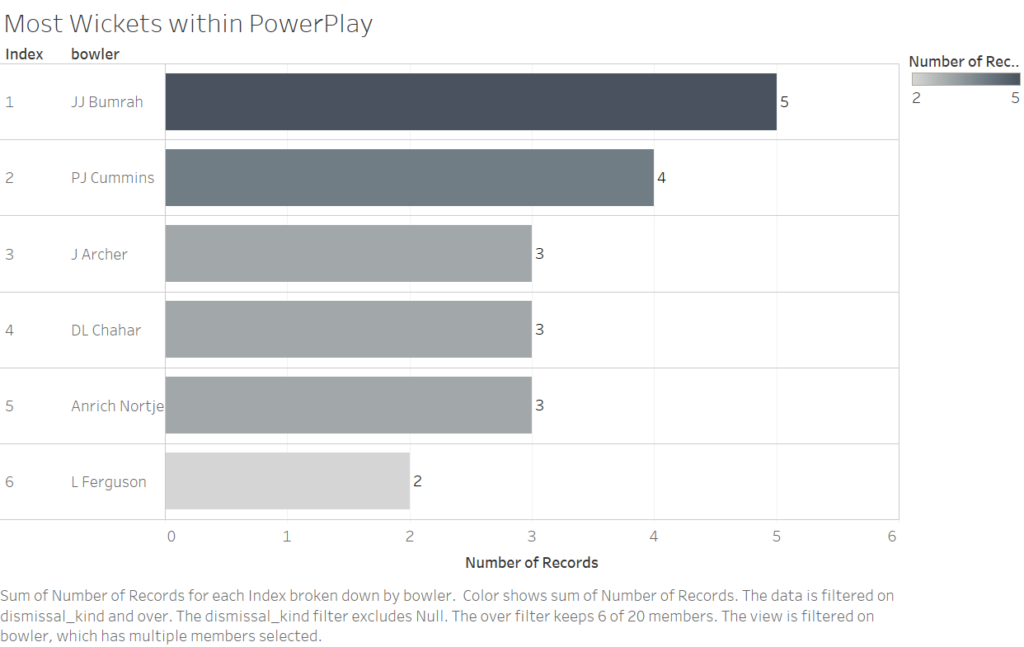
7. Most Dot Balls Bowled in Death Overs
Bowling dots in the death indicate a well-executed strategy and decisive bowling. Dot balls in death also increase the pressure on the batsman to score, thereby improving the probability for getting a wicket. Mumbai shines in this regard, as it has bowled a cumulative 138 dots in the final overs of the game. It has been often said that Chennai has thrown away matches it could have won. This is a cardinal evidence of how they failed to build pressure on the batsmen in the end overs, as the data ranks them the last in terms of dots bowled.

Final Observations
The above portrayal was a finer dissection of a mix of subtle factors that go on to decide the outcome of a game. From almost all records, Mumbai has shined through. It is in perfect consonance with the fact that Mumbai was the first team to qualify and secure the playoff berth, and also end up being ranked first at the end of the group stage. Other teams have been lacking either in the batting or the bowling department. This lack of dependability on either department for other teams ensured a nail-biting entry into the top-four from the group stages. Me being a Chennai fan boy, it was particularly disheartening to see a poor display from the Veterans Club. However, promising performances by young talent Ruturaj Gaikwad and Jagadeesan have kept hopes alive for the next season. As MS said, it’s Definitely Not over!
